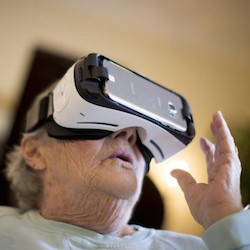
Virtual reality is increasingly being implemented in nursing homes and senior living communities to improve patients’ physical and mental health. A new VR-based platform that may soon be used to treat chronic conditions could be another game changer for senior living residents.
XRHealth, a Boston-based VR platform company, was recently awarded a US patent for a learning system technology that uses patients’ biometric and motion data to adjust disease treatment protocols.
The platform is geared toward patients on the autism spectrum and those suffering from stress, anxiety, chronic pain, fibromyalgia and neurological conditions. The new technology connects patients with healthcare providers via telehealth and then sends recommended therapies on a VR headset. Providers are also sent patient data, and patients can track their treatment via XRHealth’s app.
XRHealth’s technology will be used with the Apple Watch and Apple’s new augmented reality headset.
“The new patent enables XRHealth to tailor treatments to the direct biological responses of our patients in real time, allowing us to create powerful solutions with strong impact,” Eran Orr, CEO of XRHealth, said in a statement.
Elsewhere in the marketplace, VR has been used to improve and streamline patient care in senior living. Virtual reality could be a key in managing psychosocial disorders, and it’s more accessible, affordable and easy to use than ever, according to research in JAMDA, the journal of AMDA–The Society for Post-Acute and Long-Term Care Medicine.
A review of 10 studies involving older adults aged 68 to 87 examined the effects of virtual reality on anxiety, apathy, loneliness, depression, social engagement, quality of life and emotions, finding that benefits in treating those conditions could be observed in just a few sessions.
Researchers found that natural, “zen-like” settings such as woods, parks and beaches resulted in positive feelings and reduced negative emotions in older adults with or without cognitive impairment.


